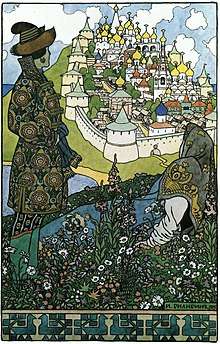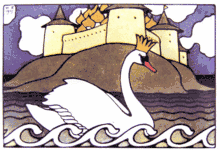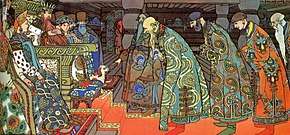The Tale of Tsar Saltan
The Tale of Tsar Saltan, of His Son the Renowned and Mighty Bogatyr Prince Gvidon Saltanovich, and of the Beautiful Princess-Swan (Russian: «Сказка о царе Салтане, о сыне его славном и могучем богатыре князе Гвидоне Салтановиче и о прекрасной царевне Лебеди», romanized: Skazka o tsare Saltane, o syne yevo slavnom i moguchem bogatyre knyaze Gvidone Saltanoviche i o prekrasnoy tsarevne Lebedi) is an 1831 fairy tale in verse by Alexander Pushkin. As a folk tale it is classified as Aarne–Thompson type 707 for its dancing water, singing apple and speaking bird.[1]
| The Tale of Tsar Saltan | |
|---|---|
 The mythical island of Buyan. | |
| Folk tale | |
| Name | The Tale of Tsar Saltan |
| Data | |
| Aarne-Thompson grouping | ATU 707 (The Dancing Water, the Singing Apple, and the Speaking Bird; The Bird of Truth, or The Three Golden Children, or The Three Golden Sons) |
| Region | Russia |
| Published in | Сказка о царе Салтане (1831), by Александр Сергеевич Пушкин (Alexander Pushkin) |
| Related | The Dancing Water, the Singing Apple, and the Speaking Bird |

Illustration by Ivan Bilibin, 1905
Synopsis
The story is about three sisters. The youngest is chosen by Tsar Saltan (Saltán) to be his wife. He orders the other two sisters to be his royal cook and weaver. They become jealous of their younger sister. When the tsar goes off to war, the tsaritsa gives birth to a son, Prince Gvidon (Gvidón.) The older sisters arrange to have the tsaritsa and the child sealed in a barrel and thrown into the sea.
The sea takes pity on them and casts them on the shore of a remote island, Buyan. The son, having quickly grown while in the barrel, goes hunting. He ends up saving an enchanted swan from a kite bird.
The swan creates a city for Prince Gvidon to rule, but he is homesick, so the swan turns him into a mosquito to help him. In this guise, he visits Tsar Saltan's court, where he stings his aunt in the eye and escapes. Back in his realm, the swan gives Gvidon a magical squirrel. But he continues to pine for home, so the swan transforms him again, this time into a fly. In this guise Prince Gvidon visits Saltan's court again and he stings his older aunt in the eye. The third time, the Prince is transformed into a bumblebee and stings the nose of his grandmother.
In the end, The Prince expresses a desire for a bride instead of his old home, at which point the swan is revealed to be a beautiful princess, whom he marries. He is visited by the Tsar, who is overjoyed to find his newly married son and daughter-in-law.
Translation
The tale was given in prose form by American journalist Post Wheeler, in his book Russian Wonder Tales.[2]
Adaptations
- 1900 – The Tale of Tsar Saltan, opera by Nikolai Rimsky-Korsakov in which the popular piece Flight of the Bumblebee is found.
- 1943 – The Tale of Tsar Saltan, USSR, traditionally animated film directed by Brumberg sisters.[3]
- 1966 – The Tale of Tsar Saltan, USSR, feature film directed by Aleksandr Ptushko.[4]
- 1984 – The Tale of Tsar Saltan, USSR, traditionally animated film directed by Ivan Ivanov-Vano and Lev Milchin.[5]
2012 Malek Rama Lakhooma, Hannibal Alkhas' Assyrian Aramaic poem, loosely based on the Pushkin fairy tale, was staged in San Jose, CA (USA). Edwin Elieh composed the music available on CD.
Gallery of Illustrations
Ivan Bilibin made the following illustrations for Pushkin's tale in 1905:
 Tsar Saltan at the window
Tsar Saltan at the window The Island of Buyan
The Island of Buyan Flight of the mosquito
Flight of the mosquito The Merchants Visit Tsar Saltan
The Merchants Visit Tsar Saltan
See also
This basic folktale has variants from many lands. Compare:
References
- Johns, Andreas. Baba Yaga: The Ambiguous Mother and Witch of the Russian Folktale. New York: Peter Lang Publishing Inc. 2010. p. 244. ISBN 978-0-8204-6769-6
- Wheeler, Post. Russian wonder tales: with a foreword on the Russian skazki. London: A. & C. Black. 1917. pp. 3-27.
- "Russian animation in letters and figures | Films | «THE TALE ABOUT TSAR SALTAN»". www.animator.ru.
- "The Tale of Tsar Saltan" – via www.imdb.com.
- "Russian animation in letters and figures | Films | «A TALE OF TSAR SALTAN»". www.animator.ru.
External links
| Wikimedia Commons has media related to The Tale of Tsar Saltan (Bilibin). |
| Wikisource has original text related to this article: |
| Russian Wikisource has original text related to this article: |
- A. D. P. Briggs (January 1983). Alexander Pushkin: A Critical Study. Rowman & Littlefield. ISBN 978-0-389-20340-7.
- (in Russian) Сказка о царе Салтане available at Lib.ru
- The Tale of Tsar Saltan, transl. by Louis Zellikoff
Further reading
- Mazon, André. "Le Tsar Saltan". In: Revue des études slaves, tome 17, fascicule 1-2, 1937. pp. 5-17. [DOI: Le Tsar Saltan [www.persee.fr/doc/slave_0080-2557_1937_num_17_1_7637 persee.fr]
